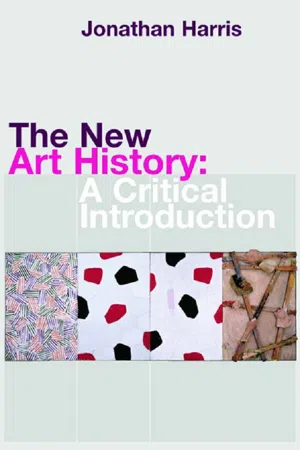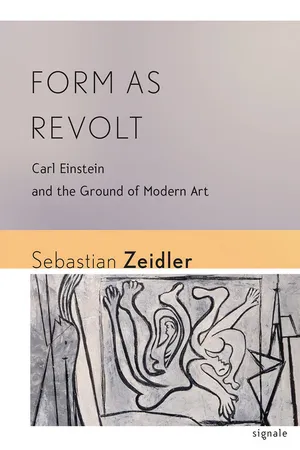History
Cubism
Cubism was an influential art movement pioneered by Pablo Picasso and Georges Braque in the early 20th century. It revolutionized traditional artistic representation by depicting subjects from multiple viewpoints simultaneously, breaking them down into geometric shapes and forms. This approach challenged the conventions of perspective and representation, laying the groundwork for abstract art and influencing a wide range of artistic disciplines.
Written by Perlego with AI-assistance
Related key terms
5 Key excerpts on "Cubism"
- eBook - ePub
Continuity and Change in Art
The Development of Modes of Representation
- Sidney J. Blatt, Ethel S. Blatt(Authors)
- 2014(Publication Date)
- Routledge(Publisher)
Cubism replaced the system of linear perspective that had dominated European art since the Renaissance. Cubism defined a new method of pictorial representation that enabled artists to integrate what they knew about an object as well as what they saw. Color, light, form, and volume became separate, independent, pictorial elements that allowed for multiple ways of representing the complexity and diversity of reality. Painting found a new freedom—it was no longer bound to a realistic representation from a single, fixed perspective. Objects were no longer defined by the surface and boundaries of closed forms, but instead a variety of colored planes were utilized to represent a synthesis of various dimensions and conceptions of objects (Fry, 1966). Cubism initiated a major revolution in the history of Western art.Arnheim (1954/1974) disagrees with the interpretation that Cubism was, at least partially, an attempt to present a fuller conception of an object by combining various aspects and perspectives. He comments:The beholder is presumably to fly on the wings of his mind from one perspective view to the other, or to find himself at different locations simultaneously. By such mental acrobatics the viewer himself would perform the dynamics actually inherent in the work. In fact, of course, he is looking not at the three-dimensional object but at a flat picture of it, in which the aspects clash in deliberate contradiction, (p. 132)Arnheim (1954/1974, p. 302) considers Cubism an attempt “to portray the modern world as a precarious interplay of independent” coherent units by intentionally setting up “visual clashes, contradictions and mutual interferences.” He views Cubism as seeking to express a fundamental disorder that exists in the incompatibility inherent in space when self-contained, separate units are not part of a continuous whole but rather interact blindly and irrationally. Arnheim stresses that only the delicate balancing of innumerable forces and angles can provide a semblance of unity, not unlike the delicate balance needed to cope with ambiguity and contradiction in contemporary thought and social relations. - eBook - ePub
- A.L. Rees(Author)
- 2019(Publication Date)
- British Film Institute(Publisher)
These were mainly aesthetic questions for Picasso and Braque, who stood rather aloof from the broadening interest in their work and the even broader conclusions drawn from it. As the latest and most dramatic shock to public taste in art so far, the new painting became both famous and notorious; a double legacy. The derisory term ‘Cubism’ stuck, however, and wider numbers of artists took up the name and explored the style in a cluster of splinter groups. Their ideas and their shows were encouraged by Apollinaire, poet and publicist of the new spirit in art.Today Cubism is seen as distinctively modern because it is sceptical, investigative, active, eclectic. It was the intellectual and artistic core of the modern movement, and is still seen as its foundation. Most major trends in art later in the century looked back to it, and some still do, as a direction to follow or challenge. The moments of Cubism still attract critical debate. Key issues remain unresolved, from anarchist readings of Picasso collages to more familiar problems of order and dating. But Cubism remains an open question for more than historical reasons. It did not begin as a movement nor did its founders seek to found one, but the ‘researches’ of two young painters took on wider importance in a period of artistic change when traditional forms and content were under attack.Their challenge was made in part by turning to non-Western sources outside the tradition and by identifying with the most radical aspects of that tradition, which is why cubist myth incorporates Cézanne, Jarry and Rousseau in a rhetoric of the innocent or even child-like eye. Echoing the machine age by turning from the central, positioning human eye, cubist collage took city life – from newspaper clippings to household wallpaper – directly into art. Even by collaborating, Picasso and Braque undermined the bravura-myth of individual authorship.Before Cubism, radical artists from the Impressionists to the Fauves regarded the space of painting as a scene opened to the eye. To this long tradition they added new sensations of colour, texture and form. City-bred Cubism questioned this notion of optical truth and of the identifications it implied, chiefly between the object and its image and between viewer and viewed. The compositional unity of what Duchamp later dubbed ‘retinal art’ fell victim to cubist syntax, which sought conceptual form rather than visible appearance.74 - eBook - ePub
The Culture of Time and Space, 1880–1918
With a New Preface
- Stephen Kern(Author)
- 2003(Publication Date)
- Harvard University Press(Publisher)
34The proliferation of perspectives and the breakup of a homogeneous three-dimensional space in art seemed to many to be a visible representation of the pluralism and confusion of the modern age. As early as 1923 Picasso tried to defend his achievement from such forced juxtapositions: “Mathematics, trigonometry, chemistry, psychoanalysis, music and whatnot, have been related to Cubism to give it an easier interpretation. All this has been pure literature, not to say nonsense, which has only succeeded in blinding people with theories.”35 This is an important reminder that Cubism came out of pressures and challenges within art. Nevertheless Cubism did influence, and was influenced by, other developments. Chronophotography and cinema no doubt had some effect, however indirect, on the way Cubists rendered space and sought to give a sense of the development of an object in time as a construction of successive points of view. X-ray must have had something to do with the Cubist rendering of the interior of solid objects. In spite of Picasso’s warning, critics continued to draw parallels between Cubism and a number of other cultural developments. Fritz Novotny suggested that the “alienation of objects from reality” in Cubism was symptomatic of a culture that affirmed the “unreality of place” and that was plagued by nihilism.36 Siegfried Giedion linked Cubism with a new sense of the many-sidedness of moral and philosophical issues.37 Pierre Francastel saw Cubism as a reflection of the fragmented space of the modern age.38 Max Kozloff saw a connection with the relaxation of rules of grammar where words are run together as in the writing of Joyce.39 Wylie Sypher stressed its similarity to the shifting perspectives of the new cinema and used it as a metaphor for the modern “world without objects.”40 - eBook - ePub
The New Art History
A Critical Introduction
- Jonathan Harris(Author)
- 2002(Publication Date)
- Routledge(Publisher)
Picasso's Cubism was one example, Russian constructivism a second, Jackson Pollock's ‘drip-painting’ a third – all three practices produced in very different historical circumstances, but all part of capitalist (in the second case, Soviet) modernity's rocky history. The Cubism of Picasso and Georges Braque between 1910 and 1911 briefly constituted what appears to have been a genuine social and artistic ‘collectivity’, admittedly of only two, Clark remarks, but in ‘bourgeois society you settle for the collectivity you can get’ (CC: 221). Yet later he is quite clear that Picasso's works are greatly superior to those of his collaborator, citing Picasso's infamous remark that Braque during this period ‘was my wife’ (CC: 223). Clark's implication is that this description expressed the harsh truth of their relationship (marriage: another failed utopian dream?), however unpalatable the acknowledgement of inequality was and remains. For Clark, the paintings produced in this moment, although utopian and ambitious, have a ‘dark mode’ (CC: 220), ‘a darkness and obscurity’ (CC: 186), that reflects their inevitable ‘epoch-making failure’ (CC: 187) to produce a new world in and from art. These paintings – and the collages, I suspect Clark would say – only look as if they have begun a cognitive revolution, which is Krauss’ grand claim for them. In fact they have produced what Clark calls ‘a counterfeit of such a description – an imagining of what kinds of things might happen to the means of Western painting if such a new description arose’ (CC: 215). 43 This apparent ‘cognitive’ shift is simply another metaphoric turn in modern art, the habit of which, he says, can be acquired by anyone; indeed ‘the history of twentieth-century painting is largely made up of people acquiring them’ (CC: 223) - eBook - ePub
Form as Revolt
Carl Einstein and the Ground of Modern Art
- Sebastian Zeidler(Author)
- 2016(Publication Date)
3
CUBISM’S PASSION
Cubism’s Originality
This chapter has a double focus. It is devoted to Einstein’s writings on Cubism as well as to the Cubism he was writing on. The term meant something quite specific to him, for his interests were highly selective. For one thing, Einstein had no patience for the Salon cubists, and while he respected the work of Juan Gris and Fernand Léger, his essays on them are short and lesser texts. For another, Einstein had no compelling things to say on the Demoiselles d’Avignon or Cubism at Cadaqués, and nothing much on collage and the papiers collés that he hadn’t stated on painting already. As for Cubism in 1914, it remained as opaque to him as to everyone else. That leaves us with the core account: Einstein on the art of Georges Braque and Pablo Picasso in 1911 and 1912. After some brief and hesitant efforts before World War I, he developed that account in The Art of the 20th Century , above all in the first and third editions (1926, 1931), and again in the monograph he wrote on Braque (1934).1 I will explore that account in some depth, by outlining Einstein’s art-theoretical thoughts and then delivering an analysis of the art in their light.But first, a summary of the story so far will be useful. We have identified the problematic that had sent Einstein on a wanderer’s quest. Whether it was socialist politics, the being of the pauper, or the visuality of an African sculpture: each time we found Einstein probing an origin, essence, or ground that was not one but two, not a substance but a relation. And each time that relation turned out to be ambivalent at best, nihilist at worst. For each time Einstein was describing, and enacting in his writing, a formal constellation in which two units were facing each other as antagonists across a void: two factions in the Reichstag, two existential moods, two aspects of a sculpture, two nouns in a clause. Einstein had tried to write an origin for modern politics and subjectivity, for sculptural experience and for experimental prose; but as that origin withdrew from him, no creation had been built on the abyss of its recession. What had emerged instead was the opposition that the recession had spawned in its wake: an opposition between divided terms around a point of indifference. The style of nonessence had written it many times across the page.
Learn about this page
Index pages curate the most relevant extracts from our library of academic textbooks. They’ve been created using an in-house natural language model (NLM), each adding context and meaning to key research topics.




